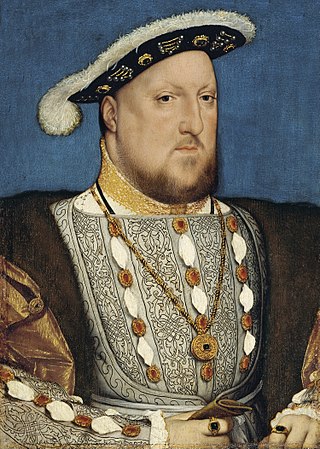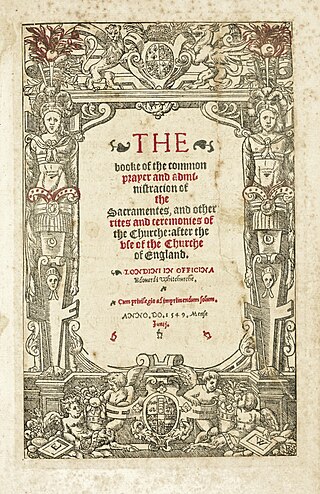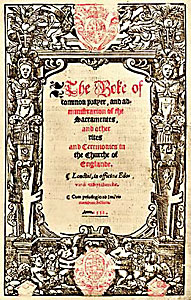
Edward VI was King of England and Ireland from 28 January 1547 until his death in 1553. He was crowned on 20 February 1547 at the age of nine. The only surviving son of Henry VIII by his third wife, Jane Seymour, Edward was the first English monarch to be raised as a Protestant. During his reign, the realm was governed by a regency council because Edward never reached maturity. The council was first led by his uncle Edward Seymour, 1st Duke of Somerset (1547–1549), and then by John Dudley, 1st Duke of Northumberland (1550–1553).

Thomas Cranmer was a leader of the English Reformation and Archbishop of Canterbury during the reigns of Henry VIII, Edward VI and, for a short time, Mary I. He helped build the case for the annulment of Henry's marriage to Catherine of Aragon, which was one of the causes of the separation of the English Church from union with the Holy See. Along with Thomas Cromwell, he supported the principle of royal supremacy, in which the king was considered sovereign over the Church within his realm.

Peter Martyr Vermigli was an Italian-born Reformed theologian. His early work as a reformer in Catholic Italy and his decision to flee for Protestant northern Europe influenced many other Italians to convert and flee as well. In England, he influenced the Edwardian Reformation, including the Eucharistic service of the 1552 Book of Common Prayer. He was considered an authority on the Eucharist among the Reformed churches, and engaged in controversies on the subject by writing treatises. Vermigli's Loci Communes, a compilation of excerpts from his biblical commentaries organised by the topics of systematic theology, became a standard Reformed theological textbook.

Nicholas Ridley was an English Bishop of London. Ridley was one of the Oxford Martyrs burned at the stake during the Marian Persecutions, for his teachings and his support of Lady Jane Grey. He is remembered with a commemoration in the calendar of saints in some parts of the Anglican Communion on 16 October.
The Exhortation and Litany, published in 1544, is the earliest officially authorized vernacular service in English. The same rite survives, in modified form, in the Book of Common Prayer.

The Elizabethan Religious Settlement is the name given to the religious and political arrangements made for England during the reign of Elizabeth I (1558–1603). The settlement, implemented from 1559 to 1563, marked the end of the English Reformation. It permanently shaped the Church of England's doctrine and liturgy, laying the foundation for the unique identity of Anglicanism.

Jan Łaski or Johannes à Lasco was a Polish Calvinist reformer. Owing to his influential work in England (1548–1553) during the English Reformation, he is known to the English-speaking world by the Anglicised form John à Lasco.

The vestments controversy or vestarian controversy arose in the English Reformation, ostensibly concerning vestments or clerical dress. Initiated by John Hooper's rejection of clerical vestments in the Church of England under Edward VI as described by the 1549 Book of Common Prayer and 1550 ordinal, it was later revived under Elizabeth I. It revealed concerns within the Church of England over ecclesiastical identity, doctrine and church practices.

Diarmaid Ninian John MacCulloch is an English academic and historian, specialising in ecclesiastical history and the history of Christianity. Since 1995, he has been a fellow of St Cross College, Oxford; he was formerly the senior tutor. Since 1997, he has been Professor of the History of the Church at the University of Oxford.
John Ponet, sometimes spelled John Poynet, was an English Protestant churchman and controversial writer, the bishop of Winchester and Marian exile. He is now best known as a resistance theorist who made a sustained attack on the divine right of kings.

The Marian exiles were English Protestants who fled to Continental Europe during the 1553–1558 reign of the Catholic monarchs Queen Mary I and King Philip. They settled chiefly in Protestant countries such as the Netherlands, Switzerland and Germany, and also in France, Italy and Poland.

The English Reformation took place in 16th-century England when the Church of England broke away from the authority of the pope and the Catholic Church. These events were part of the wider European Reformation, a religious and political movement that affected the practice of Christianity in Western and Central Europe.
Richard Nykke became bishop of Norwich under Pope Alexander VI in 1515. Norwich at this time was the second-largest conurbation in England, after London.
Anthony Gilby (c.1510–1585) was an English clergyman, known as a radical Puritan and translator of the Geneva Bible, the first English Bible available to the general public. He was born in Lincolnshire, and was educated at Christ's College, Cambridge, graduating in 1535.
Juan de Villagarcía was a Spanish Dominican from Valladolid, known as the witness to one of the statements of confession and recantation by Thomas Cranmer.
Anabaptists did not originate in England, but came from continental Europe to escape persecution from Switzerland. English Anabaptism did not touch the country as quickly as other countries since Henry VIII wanted to eradicate heresy quickly and wanted to push a unified religion in England. In fact, during his rule in 1535, Henry VIII had them deported out of England officially with a proclamation that, "Ordered Anabaptists to leave the realm within twelve days after parliament adjourned or suffer the penalty of death." In 1539 he pardoned Anabaptists with a similar proclamation to restore them to the Roman Catholic church. He wanted unity above all. While Henry VIII himself had broken away from the Catholic Church himself, Anabaptists did not face a welcoming country from the beginning of their coming to England. Both Henry and his Tudor successors have charged dissidents on the basis of Anabaptism, some of whom had not such convictions. Looking at primary sources, this means that just because they were charged as an Anabaptist does not mean they were one.
John Assheton was an Anglican priest at "Shiltelington" who is the first recorded English anti-Trinitarian.
Roger Tonge otherwise Roger Tong or Tongue was an English clergyman who served as a chaplain to Edward VI and was later appointed dean of Winchester Cathedral in 1549.

The 1549 Book of Common Prayer (BCP) is the original version of the Book of Common Prayer, variations of which are still in use as the official liturgical book of the Church of England and other Anglican churches. Written during the English Reformation, the prayer book was largely the work of Thomas Cranmer, who borrowed from a large number of other sources. Evidence of Cranmer's Protestant theology can be seen throughout the book; however, the services maintain the traditional forms and sacramental language inherited from medieval Catholic liturgies. Criticised by Protestants for being too traditional, it was replaced by the significantly revised 1552 Book of Common Prayer.

The 1552 Book of Common Prayer, also called the Second Prayer Book of Edward VI, was the second version of the Book of Common Prayer (BCP) and contained the official liturgy of the Church of England from November 1552 until July 1553. The first Book of Common Prayer was issued in 1549 as part of the English Reformation, but Protestants criticised it for being too similar to traditional Roman Catholic services. The 1552 prayer book was revised to be explicitly Reformed in its theology.












